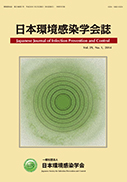Volume 24, Issue 2
Displaying 1-11 of 11 articles from this issue
- |<
- <
- 1
- >
- >|
Original Articles
-
2009Volume 24Issue 2 Pages 79-84
Published: 2009
Released on J-STAGE: June 08, 2009
Download PDF (562K) -
2009Volume 24Issue 2 Pages 85-92
Published: 2009
Released on J-STAGE: June 08, 2009
Download PDF (965K) -
2009Volume 24Issue 2 Pages 93-99
Published: 2009
Released on J-STAGE: June 08, 2009
Download PDF (700K) -
2009Volume 24Issue 2 Pages 100-105
Published: 2009
Released on J-STAGE: June 08, 2009
Download PDF (717K)
Short Papers
-
2009Volume 24Issue 2 Pages 106-108
Published: 2009
Released on J-STAGE: June 08, 2009
Download PDF (268K) -
2009Volume 24Issue 2 Pages 109-112
Published: 2009
Released on J-STAGE: June 08, 2009
Download PDF (432K)
Reports
-
2009Volume 24Issue 2 Pages 113-118
Published: 2009
Released on J-STAGE: June 08, 2009
Download PDF (574K) -
2009Volume 24Issue 2 Pages 119-122
Published: 2009
Released on J-STAGE: June 08, 2009
Download PDF (619K) -
2009Volume 24Issue 2 Pages 123-128
Published: 2009
Released on J-STAGE: June 08, 2009
Download PDF (771K)
Case Report
-
2009Volume 24Issue 2 Pages 129-133
Published: 2009
Released on J-STAGE: June 08, 2009
Download PDF (510K)
Report
-
2009Volume 24Issue 2 Pages 134-136
Published: 2009
Released on J-STAGE: June 08, 2009
Download PDF (310K)
- |<
- <
- 1
- >
- >|
